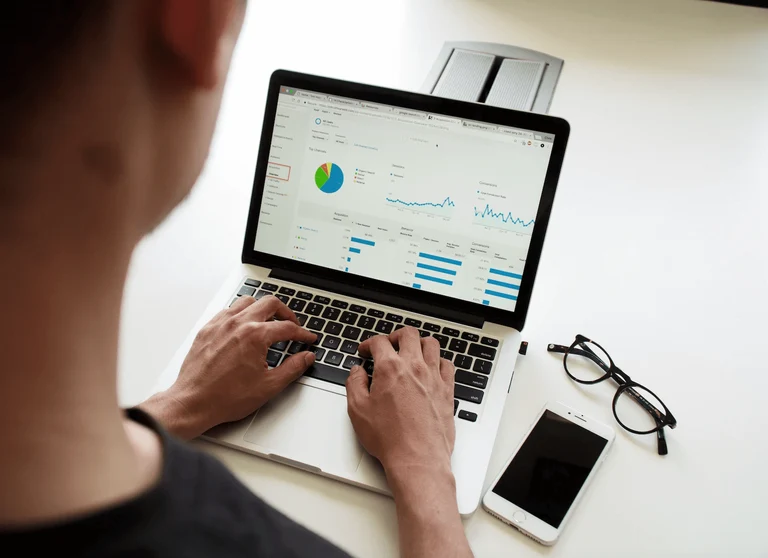What is Financial Data Analytics?
Businesses have access to more financial data than ever before. As a result, the use of data analytics in accounting is on the rise. Researchers predict that the global financial analytics market will grow by $25.38 billion by the year 2028.
As Forbes notes, there are two main reasons businesses collect and make use of data: to review a company’s performance (reactive) or to innovate (proactive). Proactive data usage involves pinpointing opportunities, reducing risk, and guiding the development of strategy. Much of the value of financial data analytics lies in its ability to offer innovative financial insights that move a business forward.

Data analytics involves the gathering and analysis of extensive data to guide accounting and business decisions through the use of technology such as AI. With the right data and tools behind them, companies can get a better understanding of their overall financial health, uncover new opportunities, optimize costs, detect fraud, and better mitigate risk.
In this post, we take a deep dive into financial data analytics and its relevancy for companies across the sectors. Let’s take a look!
Financial data analytics are key for driving in-depth insights that support data-informed financial decisions. Financial data analysts use data analytics to better understand a company’s finances.
When applied to the accounting world, data analytics can help businesses optimize business costs, enhance business efficiency, guide investment decisions, support product development, and drive new revenue. In addition, financial analytics can also be used to help effectively assess and manage a business’s assets.
A financial data analyst is typically responsible for analyzing a company’s financial data, deriving insights, and presenting their findings to company decision makers to help inform future strategy.
The Rise of Modern Technologies

Modern technologies have helped spearhead the rise of data analytics within the accounting field. Increasingly, more and more businesses are coming to rely on modern technologies and data — such as artificial intelligence, cloud computing, and machine learning.
Companies have access to more data than ever before and can use these technologies to organize and analyze this wealth of data to guide smarter financial decisions. These new technologies have helped replaced manual, time-consuming elements of financial analysis — refining and automating much of the process.
Financial Data Analytics: Providing Answers to Important Business Questions
Consulting financial data analytics can be a powerful tool in growing a business and helping to mitigate loss and risk. Deloitte highlights that finance analytics can help offer answers to some of companies’ biggest questions, including:
- How can we make our current business processes more efficient?
- How well are we managing risk with different customer segments?
- How much profit is our services or products generating across different channels and with different customers?
- Are we making the right investment decisions?
- Which factors or investments may impact our stock price?
- Which customer segments are providing the biggest boost to revenue?
What is a Financial Data Analyst’s Role?
While there are many financial data analytics companies out there, within an organization a financial data analyst is typically responsible for analyzing financial data and using it to develop strategies. On the day-to-day level, a financial analyst:
- Gathers data — often, it’s the analyst’s responsibility to source the data they must go on to analyze. This includes gathering information from internal and external data sources, such as vendor and customer data and income statements.
- Interprets the data — with the help of the right technologies, a financial analyst must analyze the data to uncover trends. Through this in-depth analysis, they identify solutions to optimize business costs, help mitigate risk, and help drive growth for the company.
- Presents their findings — an analyst must prepare reports and presentations to demonstrate their deductions to higher management and company stakeholders.
- Creates financial models to forecast, plan, and predict impacts on revenue and expenses.
- Creates and codes new algorithms to enhance the analytics process
The Pitfalls of Financial Data Analysis for Businesses
Despite the many benefits that it can offer businesses, financial data analytics can have some drawbacks you need to be aware of. Here’s how they may play out within a business:
- Slow adoption — many businesses are reluctant to move away from legacy systems and old processes that they have relied on for many years. As Sap.com reports, 67% of CFOs and senior finance professionals claim that most of their resources are still caught up with traditional systems and approaches.
- Data silos — it can be difficult to access and connect data from across a department or business. This can stand in the way of data collection and analysis.
- Privacy and transparency — customer data is a powerful source of information for financial data analysts. Customers typically have high expectations of companies that handle their data. As such, businesses need to make sure customer data is secure and well-protected against hackers and fraudsters.
The Power of Financial Data Analytics
More and more companies are looking to modernize and drive business growth with the help of the right technologies and big data. With the help of tools such as AI and cloud computing, businesses are gaining deeper insights into their finances and creating more refined, data-driven strategies to help deliver growth for their business.
Data Analytics FAQs:
Q1. What is the difference between a financial analyst and a data analyst?
Both financial analysts and data analysts study data to evaluate business efficiency and to help companies make more informed business decisions. But as their title suggests, financial analysts focus solely on financial data. In comparison, the more general term of a data analyst can refer to any professional that collects and studies data — no matter the industry. For example, they may work in the medical field or the manufacturing industry.
Q2. How do you become a financial data analyst?
What kind of educational background is needed to become a financial data analyst? A financial data analyst typically needs a bachelor’s degree in a maths-based subject. This subject is typically maths, finance, economics, or computer science. The right course helps fine-tune problem-solving skills, mathematical skills, and technical skills and offers hands-on experience in the field, such as through a work placement.
In regards to technical skills, financial data analysts must become well versed in programming languages such as Python, be proficient in Microsoft Excel, and have a keen understanding of financial models. Moreover, to become a financial data analyst, you also need to hone soft skills — including teamwork, problem-solving, and organization skills. With this experience and education, you can start to apply for entry-level positions.
Q3. What are the three main sources of data for financial analysis?
The main data sources used in financial analysis include a company’s income statement, their cash flow statement, and their balance sheet. The balance sheet provides an overview of a company’s resources. A cash flow statement offers details on a company’s performance over a set timeframe. While an income statement also provides insights into how a company has performed during a set period, it also offers non-cash accounting details.
